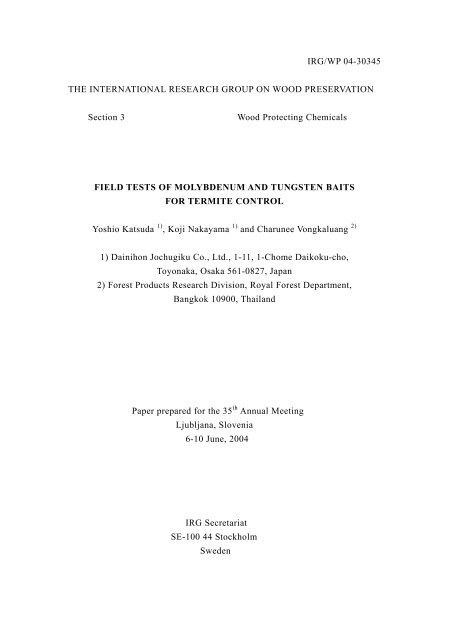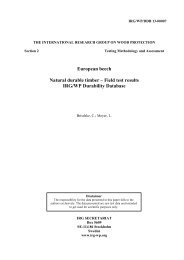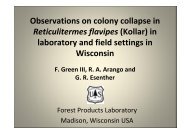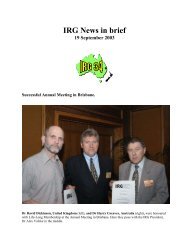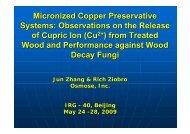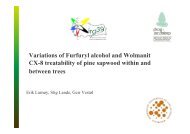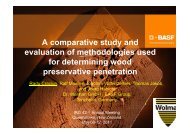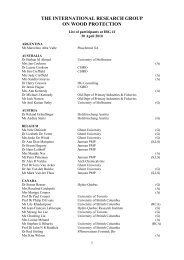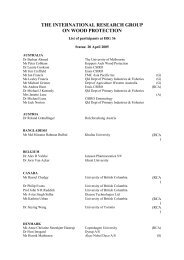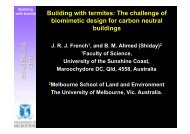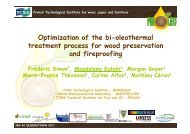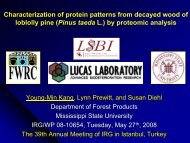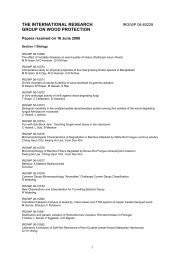field tests of molybdenum and tungsten baits - IRG. International ...
field tests of molybdenum and tungsten baits - IRG. International ...
field tests of molybdenum and tungsten baits - IRG. International ...
You also want an ePaper? Increase the reach of your titles
YUMPU automatically turns print PDFs into web optimized ePapers that Google loves.
<strong>IRG</strong>/WP 04-30345<br />
THE INTERNATIONAL RESEARCH GROUP ON WOOD PRESERVATION<br />
Section 3 Wood Protecting Chemicals<br />
FIELD TESTS OF MOLYBDENUM AND TUNGSTEN BAITS<br />
FOR TERMITE CONTROL<br />
Yoshio Katsuda 1) , Koji Nakayama 1) <strong>and</strong> Charunee Vongkaluang 2)<br />
1) Dainihon Jochugiku Co., Ltd., 1-11, 1-Chome Daikoku-cho,<br />
Toyonaka, Osaka 561-0827, Japan<br />
2) Forest Products Research Division, Royal Forest Department,<br />
Bangkok 10900, Thail<strong>and</strong><br />
Paper prepared for the 35 th Annual Meeting<br />
Ljubljana, Slovenia<br />
6-10 June, 2004<br />
<strong>IRG</strong> Secretariat<br />
SE-100 44 Stockholm<br />
Sweden
ABSTRACT<br />
FIELD TESTS OF MOLYBDENUM AND TUNGSTEN BAITS<br />
FOR TERMITE CONTROL<br />
Yoshio Katsuda, Koji Nakayama <strong>and</strong> Charunee Vongkaluang<br />
Molybdenum <strong>and</strong> <strong>tungsten</strong> compounds are slow acting to termites <strong>and</strong> show a high<br />
termiticidal efficacy. In our previous papers, we have already reported that those are<br />
useful as termiticidal ingredients <strong>of</strong> bait formulations.<br />
The dem<strong>and</strong> for natural rubber is still on the increase. However some kinds <strong>of</strong> termites<br />
inhabiting rubber plantations damage rubber trees <strong>and</strong> pose a serious threat.<br />
To cope with this problem, we prepared bait stakes by having rubber tree chips<br />
impregnated with barium salts <strong>of</strong> <strong>molybdenum</strong> <strong>and</strong> <strong>tungsten</strong> compounds <strong>and</strong> then<br />
solidifying the mixture with phenolic-type adhesive. In <strong>field</strong> <strong>tests</strong> conducted at a<br />
rubber plantation in Thail<strong>and</strong>, the bait stakes were hit into the ground around each<br />
termite mound <strong>and</strong> the level <strong>of</strong> termite activities were observed at intervals. After one<br />
<strong>and</strong> a half years from the start <strong>of</strong> the test, it was confirmed that our bait formulations<br />
eventually eradicated termite colonies <strong>of</strong> Macrotermes <strong>and</strong> Odontotermes.<br />
Key words : Molybdenum, Tungsten, Bait, Rubber plantation, Termite control,<br />
1. INTRODUCTION<br />
Macrotermes , Odontotermes<br />
Damages by termites pose serious problems in many countries. For example, termites<br />
<strong>of</strong>ten cause important damages to buildings in Japan. As main countermeasures,<br />
termiticides such as emulsifiable concentrate <strong>and</strong> oil formulations are sprayed on<br />
buildings <strong>and</strong> under the floor or surroundings there<strong>of</strong>, or anti-termitic plastic sheets<br />
containing termiticidal ingredients are employed on the ground under the floor.<br />
Silaflu<strong>of</strong>en (1-4) is regarded as an effective termiticidal ingredient, as it is<br />
characterized by excellent properties in all aspects <strong>of</strong> termiticidal activities, safety to<br />
mammals, chemical stabilities <strong>and</strong> so on. On the other h<strong>and</strong>, almost termiticides <strong>of</strong><br />
other types such as pyrethroids, organo-phosphorus compounds <strong>and</strong> carbamates which<br />
can be used as spraying agents are difficult to be mixed with plastic resins due to<br />
instability in alkaline environment, being unsuitable for applications to building<br />
materials.<br />
In China, damages by termites that eat woods or destroy embankment become social<br />
concern, <strong>and</strong> in particular, the damage <strong>of</strong> embankment by Odontotermes formosanus,<br />
Odontotermes hainanensis, Globitermes, or Macrotermes is serious. These kinds <strong>of</strong><br />
1
termites make mud tubes under the embankment, <strong>and</strong> the river water in a flooded<br />
season sinks into the mud tubes, causing a threat <strong>of</strong> destroying the embankment. To<br />
preserve the embankment, eradication <strong>of</strong> termite colonies is indispensable, <strong>and</strong><br />
conventionally bait formulations containing organic chlorine-based termiticides such<br />
as mirex have been employed for this purpose. However the use <strong>of</strong> these chemicals is<br />
banned because <strong>of</strong> residual toxicity <strong>and</strong> environmental pollution, making the<br />
development <strong>of</strong> new alternatives a pressing need.<br />
Molybdenum <strong>and</strong> <strong>tungsten</strong> compounds are slow acting to termites <strong>and</strong> show a high<br />
termiticidal efficacy. Since around the middle <strong>of</strong> 1980s, we had been engaged in<br />
development works <strong>of</strong> applying these inorganic compounds to bait formulations. Our<br />
first papers (5) on their mode <strong>of</strong> action suggested that the termiticidal effectiveness <strong>of</strong><br />
<strong>molybdenum</strong> <strong>and</strong> <strong>tungsten</strong> compounds might be much more associated with the<br />
physiological depression caused by the accumulation <strong>of</strong> their oxides in the body,<br />
especially in the fat body, rather than with the influences on the symbiotic intestinal<br />
flagellates. After that, we proceeded with formulation studies <strong>and</strong> <strong>field</strong> <strong>tests</strong> aimed at<br />
practical use in Japan <strong>and</strong> China, <strong>and</strong> reported in our subsequent papers (6-8) that<br />
those compounds are useful as termiticidal ingredients <strong>of</strong> bait formulations.<br />
Rubber trees are planted mainly in Thail<strong>and</strong>, Malaysia, Indonesia <strong>and</strong> Sri Lanka, <strong>and</strong><br />
are important as a source <strong>of</strong> supply for natural rubber whose dem<strong>and</strong> is still on the<br />
increase. At rubber plantations <strong>of</strong> these hot <strong>and</strong> humid countries, there live many<br />
kinds <strong>of</strong> termites including Macrotermes <strong>and</strong> Odontotermes which cause damages<br />
especially by attacking roots <strong>of</strong> young rubber trees (until 7-8 years old). In case that<br />
rubber trees die all at once before the harvesting season <strong>of</strong> natural rubber resin, the<br />
damages become awfully serious for the exporting nations as well as producing<br />
farmers. Countermeasures taken for the damages in the past are only physical ones<br />
such as removing surface soil (about 40cm in depth). In consideration <strong>of</strong> these<br />
circumstances, we have conducted <strong>field</strong> <strong>tests</strong> <strong>of</strong> bait formulations containing<br />
<strong>molybdenum</strong> <strong>and</strong> <strong>tungsten</strong> compounds for termite control at rubber plantations in<br />
Thail<strong>and</strong> since July <strong>of</strong> 1999. This report deals with the test results <strong>and</strong> their high<br />
practicability <strong>of</strong> the bait formulations.<br />
2. MATERIALS AND METHODS<br />
2.1. Test materials<br />
The bait formulation served for <strong>field</strong> <strong>tests</strong> is shown in Table 1. An aqueous solution <strong>of</strong><br />
sodium salts <strong>of</strong> molybdic acid <strong>and</strong> tungstic acid was impregnated uniformly in rubber<br />
tree chips, followed by the addition <strong>of</strong> an aqueous solution <strong>of</strong> barium chloride to cause<br />
formation <strong>and</strong> precipitation <strong>of</strong> slightly water-soluble barium salts <strong>of</strong> molybdic acid<br />
<strong>and</strong> tungstic acid. After drying, the mixture was hardened using phenolic-type<br />
2
adhesive under low pressure <strong>and</strong> then the molding was cut to give bait stakes (15x<br />
40x250mm).<br />
Table 1 Bait formulation for <strong>field</strong> <strong>tests</strong><br />
Materials Contents<br />
Na2MoO4・2H2O (MW:242)<br />
Na2WO4・2H2O (MW:330)<br />
BaCl2・2H2O (MW:244)<br />
Rubber tree chips<br />
Phenolic-type adhesive<br />
13.0 % (5.2% as Mo)<br />
5.0 (2.8% as W)<br />
15<br />
57~61<br />
6~10<br />
Total 100<br />
2.2. Test methods<br />
Ten <strong>and</strong> more termite mounds at Phuket Rubber Experiment Station were selected as<br />
test sites. On April <strong>of</strong> 2002, 4-6 test bait stakes (15x40x250mm) were hit into the<br />
ground around each mound, <strong>and</strong> stakes <strong>of</strong> rubber wood (40x40x300mm) were set on<br />
the top <strong>of</strong> each mound <strong>and</strong> around it if necessary. Then the level <strong>of</strong> termite activities at<br />
each mound were observed at intervals. In case that damages <strong>of</strong> test bait stakes <strong>and</strong><br />
wood stakes were found to be serious on the observation time <strong>of</strong> October <strong>of</strong> 2002, the<br />
stakes were replaced for new ones <strong>and</strong> the <strong>tests</strong> were continued.<br />
3. RESULTS AND DISCUSSION<br />
3.1. Determination <strong>of</strong> bait formulations<br />
Ahead <strong>of</strong> this <strong>field</strong> <strong>tests</strong>, bait formulations containing sodium salts <strong>of</strong> molybdic acid<br />
<strong>and</strong> tungstic acid, not converted to barium salts, were tested. The result was<br />
unsatisfactory, as water-soluble sodium salts leached out during the <strong>tests</strong>. Then we<br />
prepared solid <strong>and</strong> hard <strong>baits</strong> by hardening with phenolic-type adhesive under high<br />
temperature <strong>and</strong> high pressure, but the <strong>baits</strong> invited a reduction in bait feeding by<br />
termites. For this <strong>field</strong> <strong>tests</strong> therefore, barium salt-based <strong>baits</strong> were prepared by<br />
converting sodium salts to slightly water-soluble barium salts by ion exchange method,<br />
being free from the danger <strong>of</strong> leaching out <strong>of</strong> active ingredients. Moreover, bait<br />
feeding by termites was found not to deteriorate as the <strong>baits</strong> can be formed porously<br />
under low pressure.<br />
As base materials for <strong>baits</strong>, rubber trees were suited for termites in Thail<strong>and</strong>, although<br />
favorable base materials in Japan <strong>and</strong> China were pine trees <strong>and</strong> eucalyptus barks or<br />
bagasse respectively. This seems to indicate diversity in bait feeding according to<br />
termites on the spot.<br />
3
3.2. Outline <strong>of</strong> observation results after installation <strong>of</strong> <strong>baits</strong><br />
Results <strong>of</strong> typical test sites are summarized as Table 2.<br />
Test<br />
site<br />
Table 2 Observation results<br />
Date <strong>of</strong> installation<br />
Date <strong>of</strong> observation<br />
2002, 4 2002, 10 2003, 12<br />
I ・ Five stakes were hit<br />
into the ground around<br />
a termite mound.<br />
II ・ Five stakes were hit<br />
into the ground around<br />
a termite mound.<br />
・ Damage was found on<br />
one stake.<br />
・Activities <strong>of</strong><br />
Macrotermes were<br />
observed.<br />
・ Damage was found on<br />
one stake.<br />
・Severe damage was<br />
found on wood stakes.<br />
・Activities <strong>of</strong><br />
Macrotermes were<br />
observed.<br />
・Eradication <strong>of</strong> a nest <strong>of</strong><br />
Macrotermes was<br />
confirmed.<br />
・Three satellite nests <strong>of</strong><br />
Hypotermes were found<br />
around the former<br />
termite mound.<br />
・Live termites were not<br />
found after digging out<br />
a nest <strong>of</strong> Macrotermes.<br />
・Eradication <strong>of</strong> the nest<br />
was confirmed.<br />
After one <strong>and</strong> a half years from the start <strong>of</strong> the test, termite mounds having a height <strong>of</strong><br />
about 30 cm at the beginning became flat as shown in Pictures. Thus it was confirmed<br />
that our bait formulations eventually eradicated termite colonies <strong>of</strong> Macrotermes <strong>and</strong><br />
Odontotermes which attack rubber trees.<br />
Fig. 1 Start <strong>of</strong> the test Fig. 2 After one <strong>and</strong> a half years<br />
4
After the eradication <strong>of</strong> Macrotermes <strong>and</strong> Odontotermes colonies, activities <strong>of</strong><br />
Hypotermes were observed. This species is known to be beneficial, as Hypotermes<br />
termites cause no damage to rubber trees, eat fallen leaves <strong>of</strong> rubber trees to make<br />
organic manure, <strong>and</strong> s<strong>of</strong>ten the soil physically.<br />
Our bait formulations containing <strong>molybdenum</strong> <strong>and</strong> <strong>tungsten</strong> compounds utilize as<br />
active ingredients metal elements distributed on the earth <strong>and</strong> are not possessed with<br />
residual toxicity as organic chlorine-based termiticides, proving promising as a new<br />
termiticide. Especially, applications <strong>of</strong> the <strong>baits</strong> to rubber plantations suffering severe<br />
damages do a lot for the social welfare <strong>and</strong> their early practical use is expected.<br />
4. LITERATURE<br />
1. Katsuda, Y., H. Hirobe & Y. Minamite (Assignee: Dainihon Jochugiku)(1986).<br />
Insecticide <strong>and</strong> miticide containing arylalkylsilicon compounds, <strong>and</strong> process for<br />
producing there<strong>of</strong>. JP 61-87687.<br />
2. Minamite, Y., T. Kanzaki, Y. Katsuda & K. Nishimoto (1990). Application <strong>of</strong> a<br />
novel silaneophane (Hoe-498) to termiticides. Jpn. J. Environ. Entomol. Zool.<br />
2: 117-122.<br />
3. Rustenburg, Gb & C. J. Klaver (1991). Silaflu<strong>of</strong>en, a new insecticide against<br />
wood-boring insects <strong>and</strong> termites. <strong>International</strong> Research Group on Wood<br />
Preservation, Doc. No. : <strong>IRG</strong>/WP/3666.<br />
4. Nakayama, K., Y. Minamite, S. Koike, Y. Katsuda & K. Nishimoto (2001). New<br />
application <strong>of</strong> silaflu<strong>of</strong>en to termite control. <strong>International</strong> Research Group on<br />
Wood Preservation, Doc. No. : <strong>IRG</strong>/WP/30274.<br />
5. Yoshimura, T., Y. Katsuda & K. Nishimoto (1989). Application <strong>of</strong> <strong>molybdenum</strong><br />
<strong>and</strong> <strong>tungsten</strong> compounds to termiticides, 1. Termiticidal effectiveness <strong>and</strong> mode<br />
<strong>of</strong> actions. Jpn. J. Environ. Entomol. Zool. 1: 4-12.<br />
6. Kanzaki, T., Y. Katsuda & Y. Minamite (1994). Application <strong>of</strong> <strong>molybdenum</strong> <strong>and</strong><br />
<strong>tungsten</strong> compounds to termiticides. 8th Internat. Congr. Pestic Chem,<br />
Washington, DC, Abstract Vol.2 :Poster 1D p923.<br />
7. Umeda, M., K. Nakayama & Y. Katsuda (1997). Use <strong>of</strong> molybdate <strong>and</strong> tungstate<br />
as termiticides, 2. Semi<strong>field</strong> test. Jpn. J. Environ. Entomol. Zool. 8: 99-104.<br />
8. Nakayama, K., Y. Katsuda & K. Nishimoto (1998). Application <strong>of</strong> <strong>molybdenum</strong><br />
<strong>and</strong> <strong>tungsten</strong> compounds to bait formulations for termite control. Wood<br />
Preservation. 24(5): 330-334.<br />
5


